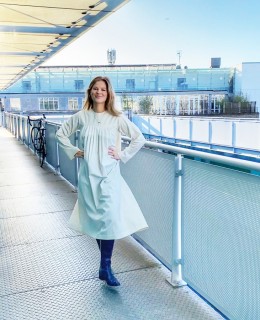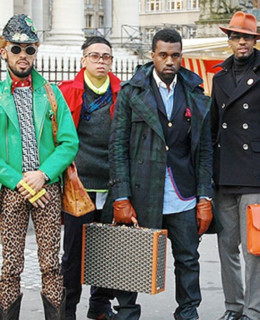Look du jour: I wear my grandma’s coat…my granddad’s boots, and Magic is showing off hìs own granddad’s horse blanket!
A 1800 military jacket with a love letter still discreetly tucked away inside its breast pocket, a gold wartime wedding dress that never made it to the altar, Albert Einstein’s lucky jacket: it’s pure, it’s poetic, it’s raw. And it’s scarce! Specialized dealers and collectors are roaming Europe, trying to unearth fashion’s biggest treasures in a race against time, decay and foreign buyers.
I’ve never been much of a thrifter, but I did love to go through my grandmother’s gigantic wardrobe as a teenager. She had the habit, passed on to her by her own mother and grandmother, to safe-keep every single item of clothing they had worn over the years and it made for a pretty impressive fashion vault. My cousin and I loved to rumble through its treasures, an activity that regularly involved high levels of shrieking. On one occasion, my rather busty partner in crime got stuck in grandma’s corseted engagement dress, clearly not designed for a modern girl’s bossom. It took us a lot of tearing and pulling, of non-breathing on her part, and a healthy dose of patience to get her out. Another time, we were going through old boxes when all of a sudden sharp fangs and two piercing eyes popped out. My great-grandmother seemingly had little to do with animal rights and would proudly wear her fox to weekly mass, which nearly caused us to a heart attack three quarters of a century later.
Equal shrieks, of horror and delight alike, resonate through old Europe as vintage hunters (re)discover or fail to acquire pieces of fashion heritage. They attend specialized fairs, scour both big city- and small town markets, thrift through endless stores, seal the occasional obscure deal with even more specialized traders who spend their days knocking on doors and sifting through attics, and lurk for –the holy grail!- big estate sales revealing long forgotten treasures of the past. The competition is fierce, it’s not like the antique stock gets refilled every other season, and there’s a strict code of silence surrounding one’s sources. Having a substantial network is key when you’re in the business and nobody dares to reveal too much of it –as I experienced while casually dropping the question at Brussel’s famed Marché aux Puces on Place Jeu de Balles at 6 o’clock on a Friday morning, which is supposed to be the time when all the professionals come out -before the good merchandise disappears back into the vans and makes place for the more regular tourist find. “It’s still a fairly rich soil for antique clothes, compared to other markets in Europe, but even here you notice the proportion of the real deal is dwindling,” says designer Eva Velazquez, who collects ancient peasant clothes and homewear for both her own label and her private collection. “More and more of it is actually just retro clothing, I don’t think there will be anything good left within ten years.” A thought echoed by Brussel’s king of vintage Bernard Gavilan, whose eponymous boutiques are located just down the street from the famous square. “People call it ‘antique’, but it’s actually just retro stuff, dating back to the sixties or seventies.”

Of course, the definition varies according to who’s asking. In Velazquez’ case, it refers to peasant blouses, vests and the famed bleu de travail, omnipresent on the countryside between the turn of last century and the thirties. She finds her liking in France mostly, popping out of the attics of farmer families and sleepy castles. Gavilan speaks of fancy Victorian wear, which in his case attracts a fair share of showbiz insiders, and for Anna Robbins, the costume designer of Downton Abbey, it’s all about authentic Belle Epoque, Edwardian and roaring twenties clothing. Indeed, all the period costumes worn in the much acclaimed TV-series and movie, are made from original pieces, carefully restored and upcycled by the designer and her team. “We’re hunting for century-old fashion here and there’s not much left of it. I find the Parisian scene very saturated, while others, mostly Scotland and England, still have some treasures to disclose. The gold wedding dress worn by Lady Rose in season 5, for instance, was tipped to me by a hunter who had found it in the attic of an old Scottish house. It was a rare find, as it had never been worn and was still wrapped in its original silk paper! Our guess is it belonged to a wartime bride who never saw her fiancee return from the front and stowed it away for ever, along with all her heartache. Heartbreaking, but the dress did get its happy ending, albeit a fictional one.”
Apart from costume designers, where else is the demand coming from? Lots of interested parties for as many different reasons, so it seems. There are designers such as Velazquez, vintage shop owners looking to grow their stock, stylists on the lookout for unique pieces to shoot in editorials or to adorn their famous clientele with, archivists who exploit their collections as a source of inspiration for modern-day labels, museum curators and finally private collectors. The latter often grow a substantial archive over the years, purely out of love for clothing and craftsmanship. Velazquez, who personally owns over 5000 pieces, does it to safe-keep our history and cultural heritage. “Once I’m gone, I hope the archive goes to a museum, or at least someone else who appreciates it as much as I do. Either way, it will return into the fashion cycle. Nowadays, clothes don’t really mean anything to us anymore while in the old days, they had a meaning and purpose –whether it be social, practical or work-related. They were part of one’s life and were truly lìved in; through those clothes, I want to wash, preserve and restore the stories they carry.”

It brings us to the restoration part, which is an art in itself. It’s the nightmare of every antique lover: uncovering a chest of, say, luxurious fur coats, only to have them disintegrate at the first touch because they have been eaten by decades of moths, mold and moist. Every collector is by definition also a specialist in pest control, knows to put wool, fur and feathers in the fridge for a few weeks upon arrival, literally freezing out every shot at life –whether it be fungus, moths or some other textile devouring beast-, keeping the light and ambient temperature at a certain level, etc. Visiting the archives of Antwerp’s famous ModeMuseum some years ago, I even discovered the storage boxes are made of a specific type of cardboard that won’t release acid gasses. A lot of antique has also been destroyed or disposed of in recent decades, as people didn’t truly realize what they were in possession of. Many clothes have been shipped off to charity and third-world countries without giving it any further thought, but nowadays awareness is gradually growing. Les Petits Riens for instance, a Belgian non-profit that collects used textile, has employed experts for a few years now to separate precious pieces from the more average donations and keep them apart for specialized sale.
Big brands increasingly have in-house historians to archive their creations. Tracey Panek for instance, is the safe-keeper of Levi’s heritage and scours the American Midwest for denim that testifies of the gold rush, cowboys and hippie rebels. Only a few years ago, she unearthed the signature brown leather jacket Einstein wore for almost half his life. The piece was auctioned for a huge sum of money, as is the case with many clothes having belonged to celebrities. Nowadays, the stage costumes of Cher or Rihanna, the wedding dresses of Kate Moss to -Middleton are all instantly archived and kept for future generations, but nobody thought of doing so for historical wardrobes such as Frida Kahlo’s or Imelda Marcos’ –which makes for both pleasant and unpleasant surprises. Regrettable: the latter’s formidable shoe collection was stowed away in a Filipino government basement for years, where it fell victim to a tropical thunderstorm and basically just rotted into oblivion. More joyful: for some reason the former’s colorful wardrobe was locked away in her house’s bathroom by her husband, and after his death nobody thought to have a second look at it, until a museum decided to catalog its content in 2004 and now the world can enjoy some endless Khalo fashion inspiration. Of course, the competition to get one’s hand on those items is even more fierce than the one firing up the regular antique market.

Speaking about competitors, there’s been one big trend in recent years: Asian buyers, especially Japanese, are snatching away flocks of antique European design. “They are truly omnipresent on the market and entire containers stuffed with the good stuff leave for Tokyo from the harbor of Antwerp each month,” says Velazquez on the masses of antique clothes that end up in expensive Asian, mostly Japanese, vintage stores known as furugiyas. “You can’t really blame them though: they have a tradition of honoring and appreciating craftsmanship. There’s their own cultural heritage of course, with kimonos, boros, etc, but then they’re also obsessed with everything European made. They understand the wealth of material, cut, details and cultural resonance, while Europeans seem to have forgotten about that. It really strikes me how much has gone East in less than a decade: if you ask me, we’ll soon need to fly over the world in order to reconnect with our own heritage!”
Sounds like the Silk Road is open for business once again, albeit working in the opposite direction. Funny trick of time it is.




